Mark Sisson's Blog, page 292
July 26, 2014
Lamb Meatballs in Coconut Fenugreek Sauce
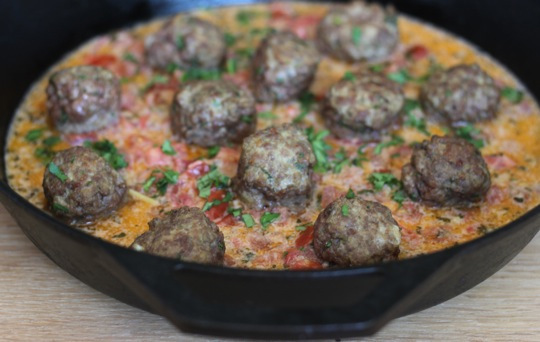 Dried fenugreek is a subtle but intriguing herb, one that adds unique flavor to sauces, meat, seafood, eggs and cooked vegetables. Slightly sweet, herbal and earthy with pleasant aromatics, it’s like adding a gentle hint of curry powder to whatever you make.
Dried fenugreek is a subtle but intriguing herb, one that adds unique flavor to sauces, meat, seafood, eggs and cooked vegetables. Slightly sweet, herbal and earthy with pleasant aromatics, it’s like adding a gentle hint of curry powder to whatever you make.
Less intense than curry powder and also less intense than fenugreek seeds or fresh fenugreek leaves, which can easily overwhelm a dish, dried fenugreek can be used in the kitchen just like any other type of dried herb. The flavor pairs especially well with other favorite herbs and spices like cumin, coriander, cardamom, fennel seeds and turmeric.
In this recipe, dried fenugreek is simmered in coconut milk with tomatoes, garlic and ginger and poured over cumin and coriander spiked lamb. Even with all those different spices and seasonings going on, the overall flavor is fairly subtle and comforting and will make your house smell really good.
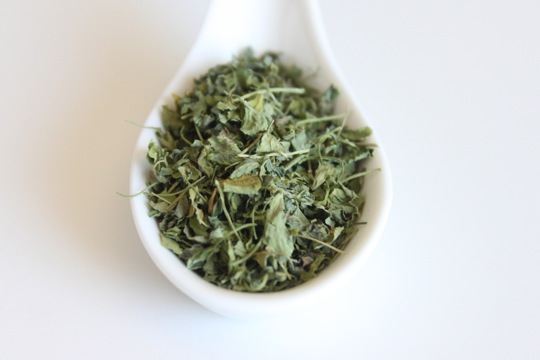
The easiest place to find dried fenugreek leaves (also labeled as kasuri methi) is in Indian grocery stores. It can also be bought from online spice shops.
Servings: 2 to 3
Time in the Kitchen: 1 hour
Ingredients:
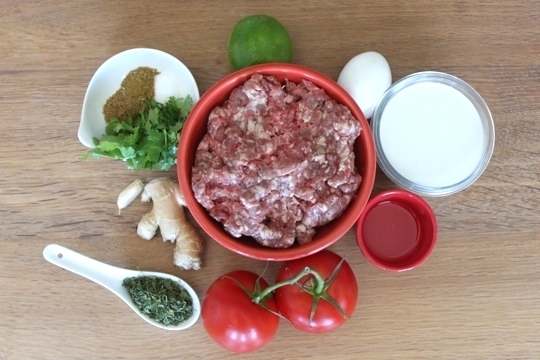
Lamb Meatballs:
1 pound ground lamb (450 g)
1 egg
3/4 teaspoon kosher salt (4 ml)
1/2 teaspoon ground cumin (2.5 ml)
1/2 teaspoon ground coriander (2.5 ml)
2 tablespoons finely chopped fresh cilantro (30 ml)
4 garlic cloves, finely chopped, divided
2 tablespoons coconut oil (30 ml)
1-inch piece of peeled ginger, finely chopped (2.5 cm)
Coconut Fenugreek Sauce:
1 cup diced tomato (about 2 medium tomatoes)
1 13.5 ounce can coconut milk (400 ml)
2 tablespoons dried fenugreek leaves (30 ml)
2 teaspoons lime juice (10 ml)
Instructions:
Preheat oven to 425 °F/220 °C.
In a large bowl mix together lamb, egg, salt, cumin, coriander, cilantro and 2 finely chopped garlic cloves. Form into about 12 golf ball sized balls. The meatballs will be loose, not tightly packed, which is fine.
Heat a skillet over medium-high with the coconut oil. Add the meatballs, browning on all sides, then transfer to a rimmed sheet pan. Bake for 10 to 12 minutes until barely pink in the middle and around 160 °F/70 °C.
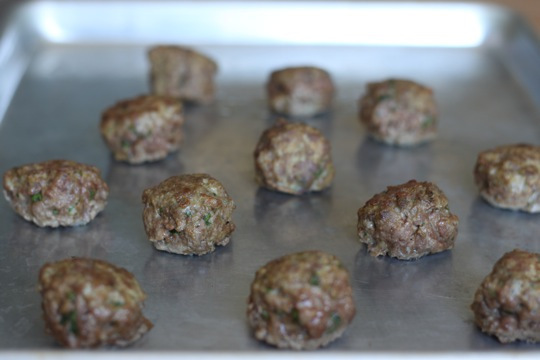
In the same skillet the meatballs were just in, sauté the ginger and remaining garlic, just until lightly browned.
Add the tomato and cook until most of the liquid evaporates.

Add coconut milk, fenugreek leaves and lime juice. Bring to a simmer for 5 to 10 minutes. Salt to taste.
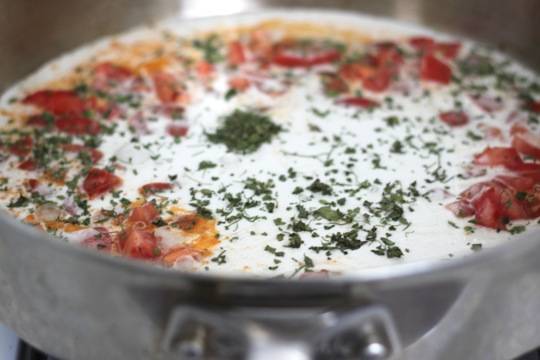
Serve meatballs and fenugreek sauce over cauliflower rice or sautéed greens.
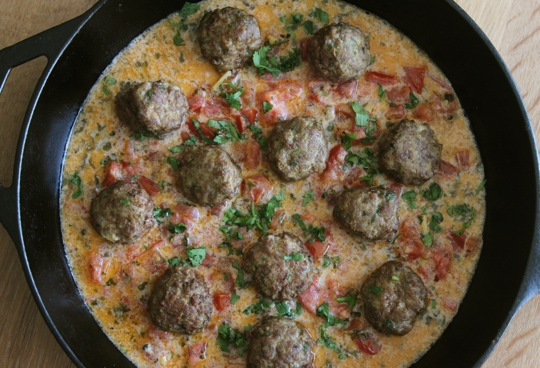
Not Sure What to Eat? Get the Primal Blueprint Meal Plan for Shopping Lists and Recipes Delivered Directly to Your Inbox Each Week




July 25, 2014
Going Primal Has Been Life Changing for Me
It’s Friday, everyone! And that means another Primal Blueprint Real Life Story from a Mark’s Daily Apple reader. If you have your own success story and would like to share it with me and the Mark’s Daily Apple community please contact me here. I’ll continue to publish these each Friday as long as they keep coming in. Thank you for reading!
 My weight struggles began when I was in my early 20’s. I was 183 cm tall and weighed in at about 110 kgs, and didn’t feel at all good about that. I felt worse when I overheard friends comment on the excess weight I carried. I decided to do something about it and went on a severely reduced calorie diet. Living on lettuce leaves (literally) by mid-1983; I weighed considerably less and ran a marathon to celebrate.
My weight struggles began when I was in my early 20’s. I was 183 cm tall and weighed in at about 110 kgs, and didn’t feel at all good about that. I felt worse when I overheard friends comment on the excess weight I carried. I decided to do something about it and went on a severely reduced calorie diet. Living on lettuce leaves (literally) by mid-1983; I weighed considerably less and ran a marathon to celebrate.
That year I changed careers and joined New Zealand Police as a constable. I was 78 kg when I went to the Royal New Zealand Police College. I was 27, and was second top fitness in my recruit wing of 43 people.
We have a Physical Competency Test (PCT) in New Zealand Police. This involves pushing a trailer 15 metres, carrying a wheel assembly 15 metres, a 200 metre sprint, hurdles (over and under), balancing beam, ‘window’ to climb through, a seven foot wall and an eight foot fence. I was always a top performer until about 10 years ago, but not because of maintained times, more because the required performance is age related (you get more time the older you are).
Every second year we are required to undergo a Physical Health Analysis Test (PHAT); based around body fat level and weight primarily. My records show that, like most that lose weight by reduced calories, I steadily regained weight. In April 1986 I weighed 78.4 kg with 13.4% body fat. It was all downhill from there! By August 1986 I weighed 86 kg, with 15% body fat. By May 1994 I weighed 92 kg and had 20% body fat. By 2000 I was back to where I started in terms of weight: 110 kg.
I tried to lose weight during 2012, managing to drop back to 107, then to 102.3 kg (see photo below). I didn’t feel great about being this size.
I didn’t have any real health problems as such, probably because of good genes (both parents are in their 80’s and in good health) and basically because I did keep fit. I was running two to three half marathons a year until about 2000. From 2009 on, arthritis in my right hip affected mobility.
I have been a Commissioned Officer at the rank of Inspector since 1998 and as such was not required to do the PCT. However the Commissioner of Police ruled in late 2012 that no member of Police could be deployed operationally (to events like the Christchurch earthquake) unless they held a current PCT.
Come 27 March 2013 I decided to do the PCT. I was way above time (by 22 seconds) and at one point fell. It was embarrassing to say the least, almost shameful.
This, combined with the pep talk my doctor gave me at my February 2013 checkup (“You are killing yourself”), was also life changing.
The Physical Training Instructor gave me a copy of Allan Carr’s book Lose Weight Now. It changed my whole attitude to food, but not wanting to go vegetarian I looked for an alternative. The answer was in the paleo food movement, and The Primal Blueprint especially. Why The Primal Blueprint and MDA? Because they outline a lifestyle, not a diet, and I wanted a new lifestyle that included diet. I subscribe to MDA and follow it avidly. Of I was looking for two words: ‘sensible’ and ‘works.’
On 2 April 2013 I went Primal/paleo.
I chucked my doctor’s advice to “eat less fat and more whole grain!” Now knowing that doesn’t work.
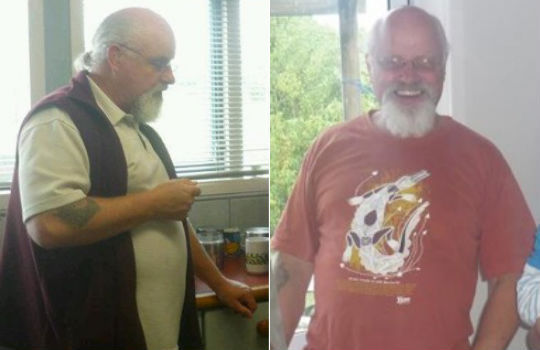
The photo on the left was taken in 2012; I weighed about 107 kgs. The photo on the right was taken in February 2013. At the start of my paleo journey on 2 April 2013, aged 57 years, I weighed 102.3 kg. My waist was 107 cm, hips 105 cm and chest 117 cm.
I lost weight quickly; by June I was 92.6 kg (waist 101 cm, hips 101 cm, chest 113 cm). The lowest I went was at the end of November 2013: 89.3 kg (waist 97.5 cm, hips 99 cm, chest 108.5 cm). But I had just had a hip replacement and was basically doing no activity. By Christmas I was back exercising, just like The Primal Blueprint recommends (lots of walking, some heavy lifting, a bit of biking, and recently, I started sprinting on a cross training machine). As I exercised, I increased weight and have stabilised at about 91.3 – 92.3 kg (waist 99 cm, hips 99 cm, chest 111 cm). My eating hasn’t changed, so I put the kilo or so added down to the increased muscle mass in my right leg following the hip replacement and exercise programme: the muscles in that leg are now noticeably bigger and more defined. I am the same weight I was 20 years ago.
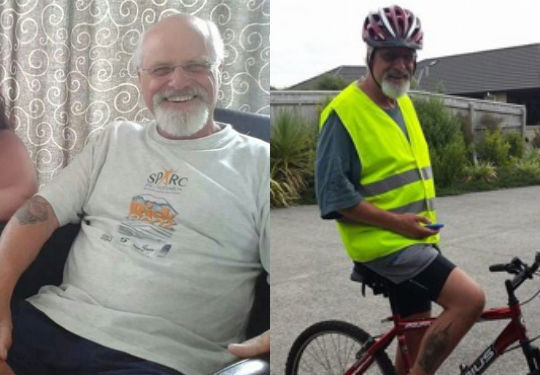
These photos were taken February 2014.
My blood tests tell an amazing story. I have a routine checkup every February. It’s all improved!
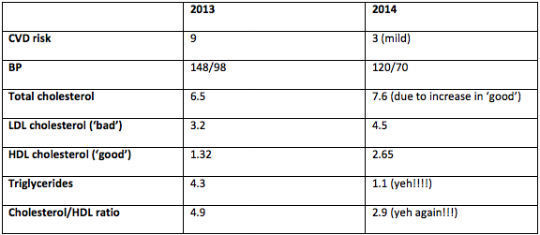
Going primal has been life changing for me. I am about 95%: I’ve had about 3 croissants, a couple of muffins and a couple of slices of genuine sourdough bread, and a couple of gluten free Easter buns over the twelve months. I’ll have the occasional ice cream, iced coffee or smoothie, or slice of gluten free cake. I have no trouble following the lifestyle; I embrace it.
One reason is this: lots of grass-fed livestock – quality food at a good price.
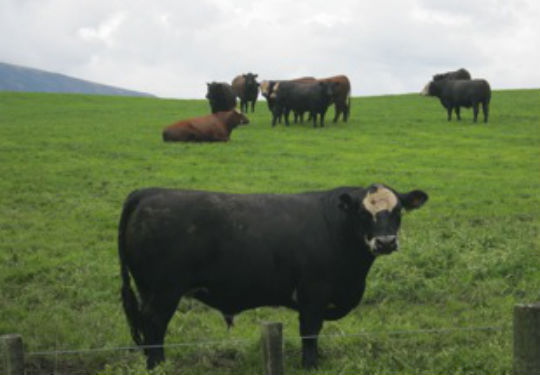
Photo taken by me, January 2014, Central North Island, New Zealand.
So what’s the Primal lifestyle done for me?
I eat better quality food
I have lost 10 kgs
Got a new wardrobe!
I am more mobile and fitter than I have been in the last 20 years
A heap more energy – all day! (I have a one hour commute by train into Wellington; I haven’t gone to sleep on the way home for months)
Enhanced credibility (as I’m no longer a fat cop!)
I can keep up with my 9 grandchildren
I feel great!
I have yet to do the PCT – I’ll hold that until one year after the hip replacement. However, having been a bushman and hunter for 30 years, on 22 April 2014 I got out into the bush for the first time in 14 months. The photo below shows me visiting a stationary boiler used for log hauling in the 1930s (Tararua Forest Park, New Zealand). About 1.5 hours from the road end, a major river to cross, generally off trail. Wearing my aqua five fingers. It’s great to be back.
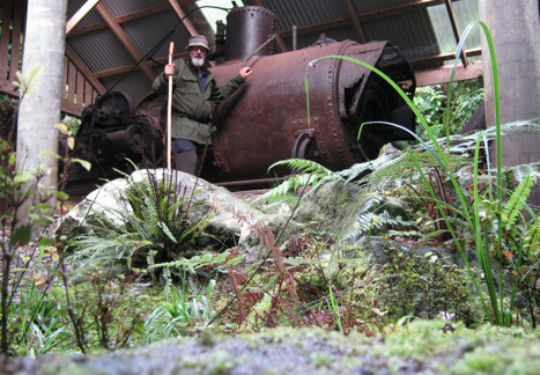
Go the Primal lifestyle!!!
Joe Green
Paraparmumu, New Zealand
Get the 7-Day Course on the Primal Blueprint Fundamentals for Lifelong Health Delivered to Your Inbox for FREE




July 24, 2014
Yearning for the Wild
 A friend called this week after returning from a two week trip to the North Woods. An IT person who works in a large metropolitan city, he was grateful for the off-the-grid escape. “You forget how much the noise and traffic and technology and busyness get to you until you take a real break totally disconnected from it all,” he said. “I tell ya, by the end of the trip I felt totally realigned. I was sleeping better. I did a ton of hiking, but I rested a lot and just enjoyed socializing and watching the lake. I was calm and not fumbling every five minutes for my phone, which didn’t really work anyway, to distract me. I could focus and enjoy the silence. By the time we left, I felt like I was pared down to who I was again.” It’s amazing what two weeks can do – in the right environment, I think. As he described the trip’s setting and sounds, I couldn’t help but think about the elixir time in wilderness is – and how it’s the most obvious thing in the world but perhaps one of the least appreciated. He couldn’t wait to get back and was already planning the next trip, swearing he’d never again deprive himself of “needed time” in the middle of wilderness nowhere. I know exactly what he meant.
A friend called this week after returning from a two week trip to the North Woods. An IT person who works in a large metropolitan city, he was grateful for the off-the-grid escape. “You forget how much the noise and traffic and technology and busyness get to you until you take a real break totally disconnected from it all,” he said. “I tell ya, by the end of the trip I felt totally realigned. I was sleeping better. I did a ton of hiking, but I rested a lot and just enjoyed socializing and watching the lake. I was calm and not fumbling every five minutes for my phone, which didn’t really work anyway, to distract me. I could focus and enjoy the silence. By the time we left, I felt like I was pared down to who I was again.” It’s amazing what two weeks can do – in the right environment, I think. As he described the trip’s setting and sounds, I couldn’t help but think about the elixir time in wilderness is – and how it’s the most obvious thing in the world but perhaps one of the least appreciated. He couldn’t wait to get back and was already planning the next trip, swearing he’d never again deprive himself of “needed time” in the middle of wilderness nowhere. I know exactly what he meant.
It’s a natural thing to pine for – the open sky, the huge expanses of water, the wild landscapes. Those of us who live in cities perhaps feel the pull more keenly, but I venture to say we all crave nature to some degree. For the more adventurous, it might be tapping into the wild of self and environment that hooks us. The power we witness in bodies of water or mountains shakes us out of agitation or ennui, tempting us toward challenge and even risk that stirs our life blood. For others of us, we might feel more drawn to the peace and constancy of nature. The immensity of it can bring us back to right size. Natural sound can drown out the mental chatter and help us find stillness again.
It’s a still relatively “young” field, but research into the human connection to nature spans theories as diverse as psychoevolutionary theory, indigenous consciousness, naturalistic intelligence, and biophilia. (PDF) We understand the mentally and physically healing power of nature, the spiritual dimension of time in wilderness, the cognitive benefits of time in green space.
What’s less understood is the importance of depth and directness. Children who take school breaks (a.k.a. “recess”) in schoolyards with woods and other “natural terrain” environments experience less stress and show longer attention spans than those who play outside on traditional paved play areas. (Rest assured we adults glean the same psychological and cognitive benefits.) Likewise, unfiltered sensory experience matters. Research has also shown genuine views of actual nature offers more “restorative” effects than do technological images. In the end, our brains crave the real deal. There’s no fooling basic biology. Seriously, why do we bother trying? There’s a certain nonsensical denial and intellectual grandiosity in the presumption that the cerebral inventions of the last hundred years could somehow erase or dupe hundreds of thousands of years of evolution.
The drive is built into each of us even if the felt impulse is experienced differently. For some of us, pining for time in the wild can register as an actual ache. We feel like a proverbial fish out of water – as, generally speaking, we are and literally yearn to drop ourselves in the middle of the woods. In certain times of life when grief or other emotional disorientation settle in, we may instinctively seek out the wild to feel a part of ourselves that’s still intact and capable of peace. Maybe we simply experience it as an overwhelment with nature being the central (and perhaps temporarily forgotten, as in my friend’s case) remedy to the jangled, burned out condition living without the wild eventually imposes. Finding our way to a wild space finally clears the mental debris of our modern existence and restores a certain homeostasis.
Peter Kahn, a well-known researcher into the human connection with nature, talks about the difference between “direct harms” and “harms of unfulfilled flourishing,” by which he means “physical, material, or psychological benefits that do not occur but could have and sometimes rightly should have” but we may forgo because of the set up of our environment. In other words, we’re harmed by not experiencing something that would’ve allowed us to further flourish in life. It’s the comparison between surviving and thriving. (That doesn’t at all sound familiar, does it?) Without nature, Kahn suggests provocatively, we can live as “biological meat,” but we forego something essential to fulfilling our humanity and living our full capacity.
I think that’s what my friend meant when he said he felt like he was “pared down” to who he was again. The extraneous static dissipated in those two weeks for him, and he was able to access a part of himself that lived untapped – unactualized. No wonder we get away into the wild somewhere and so many of us claim we can breathe again – literally and figuratively. For him, it was the North Woods, but we all have terrains in mind that have perhaps similarly brought us back to ourselves. Think about what those places have been for you. When’s the last time you were back there? What about this coming weekend?
Thanks for reading, everyone. What does this “pull” of nature feel like to you? How and when does the impulse to wilderness come to you? Share your thoughts and favorite spaces. Have a great end to the week.
Join Mark Sisson and Friends in Sunny Southern California this Sept. 25-28! Get Your Tickets for PrimalCon Oxnard 2014 Today and Finally Meet Your Tribe!




July 23, 2014
The “Dangers” of Going Gluten-Free
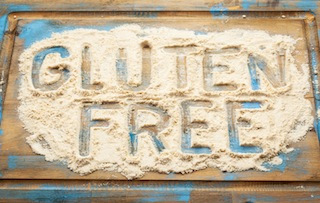 In just about every article discussing the growing popularity of gluten-free diets, an expert or two appears three quarters of the way down warning about the “dangers” of attempting a gluten-free diet without medical supervision. The first reaction – from people like you and me who have experienced real benefits giving up gluten-containing foods – is a strong eye roll. “This again?” you think. Next they’re going to say that refined sugar is an important food group and I need a high-carb diet for “brain function” or something similarly inane.
In just about every article discussing the growing popularity of gluten-free diets, an expert or two appears three quarters of the way down warning about the “dangers” of attempting a gluten-free diet without medical supervision. The first reaction – from people like you and me who have experienced real benefits giving up gluten-containing foods – is a strong eye roll. “This again?” you think. Next they’re going to say that refined sugar is an important food group and I need a high-carb diet for “brain function” or something similarly inane.
But hey, these are medical experts with acronyms after their names. Maybe we should listen to what they’re saying and investigate their justifications for saying it. What dangers or risks are they actually referring to? Are they real dangers that we should heed, or are we in the clear?
There appear to be three primary arguments against widespread adoption of gluten-free diets. Let’s examine the evidence for and against each.
“Gluten-free diets put you at risk of vitamin and mineral deficiencies.”
Is wheat actually nutritious? Wheat flour must, by law, be fortified with calcium, iron and the B-vitamins folic acid, thiamin, niacin, and riboflavin. Flours commonly used in gluten-free products, such as rice flour, potato flour, corn meal, and tapioca, are not fortified with nutrients. Those are all important nutrients that everyone needs to be healthy, and so by replacing wheat with gluten-free products made from flours without those nutrient fortification stipulations, a newly gluten-free individual can suddenly find himself embroiled in a nutrient-sparse diet. This is a problem, to be sure, but it’s not about lack of gluten. It’s about a lack of fortification.
A recent study attempting to address this question reveals a few of the nutrients we’re supposedly missing from our gluten-free diets. Whole grains are a little better than refined grains, it turns out. After all, the nutrient fortification program is designed to replace some of what the refinement process eliminates. So, what exactly are we missing out on by eliminating gluten from our diet? Whole wheat (which includes the bran and germ) beats out other common starch staples in many nutrients. Here, check out the Wikipedia (I know) page for wheat, which compares the nutrient values in a handy table. Looks impressive, right? But wheat is not the only way to get those nutrients. It’s certainly not the best way. To wit:
Manganese: Also found in nuts, pineapple, and bivalves like mussels and clams.
Betaine: The second richest source after wheat germ is spinach.
Folate: Leafy greens, pastured egg yolks, and animal livers (especially chicken) are very high in folate. So too is kefir, if you go for that kind of thing.
Copper: Ruminant liver once a week gets you all the copper you’ll need. Alternately, eat dark chocolate and oysters.
Zinc: Red meat and oysters.
Selenium: Brazil nuts (just one will do), kidneys, pastured eggs, wild salmon.
In the conclusion of that first study, the authors lament the lack of “high nutritional and tasty cereals that are naturally gluten-free” with which to construct suitable replacement junk food for gluten-free dieters. I can think of a few worthy replacements, but they don’t involve grains. There’s no need for wheat at all, provided you don’t just eat and rely on gluten-free baked goods. Another study confirms this, suggesting that people on a gluten-free diet should increase their intake of fruits and vegetables. This will replace all the micronutrients wheat can offer us, plus the phytochemicals and antioxidants that wheat by and large cannot.
Takeaway: Wheat is an attractive and important source of micronutrients for those folks who won’t eat green vegetables, red meat, nuts, bivalves, and liver. But for those of us who relish those foods and the many other nutrients they provide, wheat offers nothing special. Try not to live on lean steak and green beans or anything crazy like that. Just eat from the incredibly varied Primal table (including the weird stuff every now and then) and you won’t miss the meager offerings of wheat.
“Gluten-free diets decrease levels of good gut bacteria and increase levels of bad gut bacteria.”
A while back, this study made the rounds. Anyone who wanted to ridicule people on elective gluten-free diets could now do it with a study under their belt. Never mind the fact that they rarely actually read the full study. Never mind the fact that they didn’t understand the significance of a shift in gut microbiota composition. They just knew that it was “bad”, that it was proof we gluten-abstainers were foolish and wrong. But the actual study paints a slightly different picture. Actually, a phrase embedded in the quote in the abstract says it all. Healthy gut bacteria decreased and unhealthy bacteria increased parallel to reductions in the intake of polysaccharides after following the GFD.
The gluten-free diet wasn’t hard on the subjects’ gut bacteria because gluten was absent. It was hard on their guts because it was poor in fermentable substrate for the gut bacteria to consume. They replaced whole wheat based foods with refined grains and starches that happened to be gluten-free. Whole wheat is a decent source of prebiotic fiber, if nothing else, and that fiber feeds the bacteria. Rice flour, (cooked) potato flour and starch, tapioca flour, corn meal, and most other gluten-free flours or starches used in gluten-free packaged foods are poor sources of prebiotic fiber. Starved of food, the beneficial gut bacteria get crowded out by the pathogenic bacteria.
If you look at the PDF detailing the RS content of various foods, you’ll see that grains are the top source of resistant starch in the diets of most industrialized nations. They’re not incredible sources, they’re not dense sources, but they’re all most people have. Your average American isn’t making green banana smoothies, eating cooked and cooled potatoes, and stirring raw potato starch into sparkling water. They’re chowing down on wheat and other cereal grains.
Takeaway: If you’re going gluten-free, you have to replace the fermentable fiber in whole grains with the fermentable fibers and resistant starches in fruits, vegetables, green bananas/plantains, cooked and cooled potatoes, and raw potato starch. This will surpass and improve upon the modest amounts of said fibers/resistant starches found in wheat and other gluten grains. Most of you already know this (the subject has received a lot of attention on this blog for years), but it’s important to pass this on to others who may not.
“Gluten-free diets may morph into eating disorders.”
This is an interesting claim, perhaps the most relevant to the Primal crowd. Anyone who takes a keen interest in how specific foods affect their health, both long-term and short-term, runs the risk of lapsing into paralysis by overanalysis. I’m talking about:
Being deathly afraid of a little canola oil (I hate it, but c’mon).
Worrying about the PUFA content of that rotisserie chicken so much that you just go hungry.
About to dig into some BPA-free sardines until you start wondering just what they replaced the BPA with.
Feeling like having some ice cream as a treat, but you end up standing in the aisle with the freezer door open scouring Pubmed on your smartphone for any adverse effects of the stabilizer used in the salted caramel for so long that they all melt and you go home empty-handed.
Taking a wide berth around the bakery counter in Whole Foods to avoid breathing in any airborne gluten particles.
I get all that. Given the choice, I’d have my food cooked in butter or olive oil every time. I’d only consume pastured, bug-eating chickens and their eggs. I wouldn’t eat foods packaged in plastic, would have my butcher pack my meat up in glass tupperware rather than wrap it in plastic. And I avoid gluten as a general rule. But I don’t base my life around it. I don’t let those preferences predominate and overshadow everything else. Because that’s a perfect world and you can’t ever get that. It doesn’t exist. You can’t be perfect. Being perfect is imperfect, even. It takes too much work and too much stress.
Take it from me – a guy who despite being sensitive to the effects of gluten will have a polite bite or two of cake if someone made it for me and really put a lot of care into it. As long as you’re not eating it regularly, as long as you’re just “nibbling” every once in awhile, and as long as you’re not celiac or highly sensitive to gluten, you will be okay. I’ve gotten to the point where those nibbles and those polite bites don’t bother my gut (giving up alcohol has certainly helped with that, as has resistant starch), but a full on slice of cake or a big hunk of bread absolutely will. Find your tolerance point and hover there. Don’t pass it, don’t worry too much if you stay below.
It’s important to distinguish between “preference” and “fear.” I prefer not to eat grains. I don’t fear them. I prefer not to eat a high-carb diet. I don’t fear carbs or think them evil. I prefer to avoid gluten – and feel better when I maintain that. But I don’t fear gluten.
Takeaway: If you’re not celiac or gluten-sensitive, don’t freak out if a stray bread crumb lands on your plate or the sushi place is out of tamari sauce. You’re probably going to be just fine. You consume food. Food isn’t supposed to consume you. Don’t let it.
What’s the bottom line? Provided you have a reasonable head on your shoulders, you shouldn’t require medical supervision to successfully and safely adopt a gluten-free diet. A proper Primal way of eating that includes leafy greens, fermentable fiber, resistant starch, the occasional slab of liver, seafood, and plenty of other nutrient-dense plants and animals will support your gut health, provide sufficient micronutrition, and promote a healthy relationship with food. The “dangers of going gluten-free” are worth noting and are probably relevant for your average consumer scrambling for room on the bandwagon, but I think we’re in the clear.
What are some other “dangers” of going gluten-free? Did I miss anything?
Thanks for reading, everyone.
Get the 7-Day Course on the Primal Blueprint Fundamentals for Lifelong Health Delivered to Your Inbox for FREE




July 22, 2014
Is It Primal? – Nut Milks, Maca Root, Stinky Tofu, and Other Foods Scrutinized
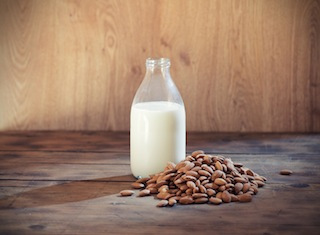 It’s been awhile since we’ve done one of these, hasn’t it? I had thought I’d exhausted the pool of foods and supplements for the “Is It Primal?” series, and that I’d be scraping the bottom of the barrel. Well, I was wrong. The questions about specific items have been pouring in unabated, and today it’s time to cover the next round of questionable foods. First up are nut milks, a perennial favorite of the dairy-free paleo world. Then I cover the widely used root with purported aphrodisiac qualities, maca, followed by stinky, smelly, grimy, pungent fermented tofu. There’s that word – “fermented” – that always makes us stop and reconsider a food. After that, I explore the suitability of azomite, a garden soil amendment and livestock feed supplement that some humans use as a mineral supplement. Last up are glass noodles made from mung bean starch.
It’s been awhile since we’ve done one of these, hasn’t it? I had thought I’d exhausted the pool of foods and supplements for the “Is It Primal?” series, and that I’d be scraping the bottom of the barrel. Well, I was wrong. The questions about specific items have been pouring in unabated, and today it’s time to cover the next round of questionable foods. First up are nut milks, a perennial favorite of the dairy-free paleo world. Then I cover the widely used root with purported aphrodisiac qualities, maca, followed by stinky, smelly, grimy, pungent fermented tofu. There’s that word – “fermented” – that always makes us stop and reconsider a food. After that, I explore the suitability of azomite, a garden soil amendment and livestock feed supplement that some humans use as a mineral supplement. Last up are glass noodles made from mung bean starch.
Nut Milks
The nut milk area is that rare grocery store intersection of otherwise disparate dietary persuasions where strict paleos sporting Cordain print Ts (not sure if such a thing exists but it should), board shorts, and bleeding callouses awkwardly butt heads with vegans looking for something to pour over their quinoa-hemp-sprouted lentil granola. Whatever their background, most people turn to nut milks for what they do not contain – casein, lactose, saturated fat, and the like – rather than for what they contain. And let’s face it: nut milks aren’t very nutrient dense. A mere handful of almonds goes into the average jug of store-bought almond milk, and you’re not even getting everything the almond itself offers. You’re getting but a crude extract.
If you can tolerate grass-fed milk and you want a milky fluid, I say go for the milk. It’s rich in calcium, whey, healthy saturated dairy fats, potassium, and it’s actually a real food with a proven track record. If you want good nut milk, however, you’ll probably just have to make your own. Use at least a 1-to-3 nut to water ratio (or smaller if you prefer), blend, and strain/squeeze through a cheesecloth. Save the nut solids to add to smoothies (a good source of prebiotic fiber) or to use in a sauce, like one of Chef Rachel’s famous nut dips. Or heck, if you were planning on making a smoothie using almond milk, just add some water and almonds to the blender with all the other ingredients you were already going to use and cut out the middle step altogether.
Store-bought nut milk, in my experience, is just cloudy water. This could all be solved if nuts would just grow breasts, but I don’t see that happening (although that opens up a huge opportunity to GMO researchers).
Verdict: Primal, but why bother?
Maca Root
Maca root is, well, a root that hails from the Peruvian Andes. It’s actually a member of the brassica family, along with broccoli, cabbage, kale, and other similar vegetables. In Peru, maca root was traditionally used as a root vegetable (like a turnip or radish), as well as for its pharmacological properties as an aphrodisiac and subtle stimulant. Incan warriors, the stories say, would use ample amounts of maca root as a preworkout booster before battles.
Does it work?
Yeah, there’s good evidence that it’s an effective adaptogen, with habitual Andean consumers of maca showing lower levels of the inflammatory cytokine IL-6 and better general health. Adaptogens are substances that improve and support the body’s natural regulation of stress. Rather than push you in one direction regardless of your health status, they right the ship. You’re still doing the work. The adaptogen is simply helping you do it. If a heightened stress response is required for health, an adaptogen will theoretically enable that. If a lowered stress response would help more, it’ll enable that too. So maca isn’t working like Viagra. It’s not forcing the issue. It’s helping you deal with the stressors that may be inhibiting your sex drive without actually affecting the reproductive hormones.
So in addition to improving erectile function, increasing general sexual function (in both men and women) and libido, and helping to resolve SSRI-associated sexual dysfunction, maca may also:
Reduce depression and blood pressure in postmenopausal women.
Improve general well-being.
Increase sperm production.
And those are just the human studies.
Maca has an oddly malty taste that some enjoy and some find repugnant. If you add it to a smoothie, including some cocoa powder can really make the maca more bearable. I’d shy away from raw maca and opt for gelatinized (cooked) maca, since that’s how it’s traditionally been consumed.
Verdict: Primal.
Stinky Tofu
There are two kinds of stinky tofu. There’s tofu that’s been left out and forgotten underneath the dorm room bed of some college freshman “trying out” vegetarianism (and probably Buddhism) for half a semester. Don’t eat that. Definitely not Primal. There’s also fermented tofu, tofu that’s been deliberately inoculated with probiotic bacteria and left to ferment and complexify and, yes, develop a particular odor. Though it’s soy and tofu and these are usually off limits, the fermentation muddles what would normally be a cut and dry dismissal.
Fermentation changes soy in several ways. It makes the soy isoflavones more biovailable. Without fermentation, we can’t really make use of them. It also reduces the phytic acid content. And as far as soy sauce is concerned, the true fermented stuff has increased levels of antioxidant compounds.
That’s fermented soy in general. What about stinky tofu? Stinky tofu has an impressive variety of probiotic bacteria, but we know very little about the potential therapeutic (or toxic) effects of the species therein. Several novel strains have been isolated from stinky tofu brines, strains that have never been studied or found in other foods. Chances are they’re safe and perhaps even helpful, since stinky tofu is a traditional food with a solid history of safe consumption and other fermented foods are beneficial. But we can’t know for sure.
Should you eat it? Industrial stinky tofu often gets a quick one or two day vinegar brine akin to mass-produced pickles. It’s stinky but not technically fermented, so steer clear. If you’re going to splurge on some stinky tofu at a Chinese restaurant, try to confirm that it’s the legit stuff and then give it a whirl.
Verdict: Not Primal, but worth trying the real stuff if you come across it.
Azomite
Millions of years ago, settling volcanic ash joined with mineral-rich river water in an ancient seabed to form azomite, a trademarked silica ore extracted from a Utah mineral deposit whose unique geologic history gives it an interesting mineral composition. A teaspoon of the stuff represents a veritable who’s who of trace minerals (PDF), making it quite attractive to certain parties interested in upping their mineral intake – especially the hard-to-find minerals that don’t come in your average supplement. The Weston A. Price Foundation calls it a superfood.
It’s not sold for human consumption, however. It is sold for livestock feed supplementation, indicating that mammals can consume it safely enough, but I don’t know – I plan on living way longer than a cow, a goat, or some chickens somewhere. I don’t base my safety assessments on whether or not a goat can eat it without keeling over. That said, it’s probably a good source of minerals, including the trace ones whose health effects we don’t know much about but which may be important and crucial. Its composition may be similar to the dirt and dust we accidentally consumed as wild humans living and eating outside, so I suppose there’s an argument for a light dusting on the salad every now and then. Then again, the real “benefit” from dirt lies in the steady exposure to low levels of soil-based bacteria; azomite is sterile and lifeless and a poor source of these probiotics.
Verdict: Not Primal. Maybe useful, probably safe, inadequate evidence either way.
Mung Bean Starch Glass Noodles
Right off the bat, this one has a few hits against it. First, they’re noodles, and noodles are usually advised against. Second, they’re made from refined starch, which we tend to avoid if we can. Third, the starch is derived from a legume, a food group that’s off the Primal menu for the most part. And yet despite all those strikes, I’m generally supportive of glass noodles while eating Primal. How can this be?
The noodle is just a medium of energy delivery. It’s not inherently bad.
Mung beans are an excellent source of resistant starch. You know, that starch that doesn’t really act like most starches. That starch that doesn’t spike blood glucose, that actually improves our ability to tolerate glucose and increases insulin sensitivity. If you want to hear more about resistant starch and why you should probably be eating it, just read the Definitive Guide to Resistant Starch I wrote a few months ago. Resistant starch explains why in a recent study into the glycemic index of six different Thai noodle and two rice varieties, glass noodles elicited the lowest GI response of all.
Mung bean starch is just that – starch. The protein is removed during the starch refinement process and with it, the lectins, phytic acid, and other potential antinutrients. Mung bean starch shouldn’t pose any issues in that respect.
Other types of glass noodles are made from other starch sources that may not be as beneficial as mung bean starch. Just look at the ingredients. They should read mung bean starch and water, nothing else.
Verdict: Primal.
That’s it for today, folks. What do you think? Are you going rush out and try something new, or throw something out? Did I crush any dreams?
Thanks for reading.
Like This Blog Post? Dig Deeper with Primal Blueprint Books and Learn How You Can Reprogram Your Genes to Become Leaner, Stronger and Healthier




July 21, 2014
Dear Mark: Growing Appetite, Boxing as Cardio, and Ammonia Sweat
 For today’s edition of Dear Mark, I’m covering three questions from readers. First, how does a Primal family handle the growing appetite of a growing prepubescent without resorting to cheap fillers? It may involve reassessing our definition of “filler,” for one. Second, does boxing – an intense, demanding sport by any measure – qualify as chronic cardio? It’s intense, to be sure, but what if you really, really enjoy and thrive doing it? And finally, should you worry if your sweat smells like ammonia? Some say it’s a sure sign of impending doom, others wave it off as totally benign. Find out what I think below.
For today’s edition of Dear Mark, I’m covering three questions from readers. First, how does a Primal family handle the growing appetite of a growing prepubescent without resorting to cheap fillers? It may involve reassessing our definition of “filler,” for one. Second, does boxing – an intense, demanding sport by any measure – qualify as chronic cardio? It’s intense, to be sure, but what if you really, really enjoy and thrive doing it? And finally, should you worry if your sweat smells like ammonia? Some say it’s a sure sign of impending doom, others wave it off as totally benign. Find out what I think below.
Let’s go:
Dear Mark,
We have a growing 12 year old boy whose appetite has also been growing with him. His diet is 75% primal as he eats what we eat with a few exceptions (bun with burger, occasional pasta etc). We obviously want to stay away from the easy cheap fillers – white rice, potatoes, pasta so do you have any suggestions as to how we can feed his appetite without having him eat us out of Primal house and home? What foods/dishes would you recommend we incorporate into his diet that will satisfy his hunger while also continuing to live a healthy lifestyle?
Thank you,
Sarah
Honestly, don’t underestimate the power of the filler. Growing kids sometimes just need sheer caloric density to maintain and support that growth. Yeah, micronutrients are extremely important, but you can’t satisfy all his caloric requirements with kale, chard, oysters, liver, and wild blueberries. Provide ample amounts of healthy fats, animal parts, and vegetables at every meal – which it sounds like you’re already doing – and round out the calories with some “filler” foods that contain starch to provide caloric bulk.
I can hear you balking. Adults for whom growth means bigger belts and added risk of chronic diseases? Filler foods should be limited, absolutely, in favor of the most nutrient-dense foods you can find. Kids are a different story. Growth is good, is physiological rather than pathological, and they need both. Some ideas:
White potatoes: Believe it or not, white potatoes are quite nutritious. And they make a good source of resistant starch when allowed to cool overnight in the fridge. They get a bad rap because of french fries fried in two day-old reheated oil, hash browns cooked in vegetable oil, potato chips, and other junk food. That’s how most people eat potatoes (and it’s why they’re the most widely consumed vegetable in the US).
Sweet potatoes: Primal darlings, the sweet potato family is both carb and nutrient-rich and perfect for a growing boy in need of energy. Check out an Asian grocer for the purple Okinawan sweet potatoes for a massive dose of anthocyanins (the purple pigments with antioxidant effects, also found in blueberries and other purple/blue foods).
White/wild rice: Yeah, rice. I said it. It’s easy to make, it’s relatively devoid of antinutrients, and it can be a great vehicle for nutritious ingredients. Best of all, rice absorbs anything you add to the cooking water. For example, instead of water, use homemade bone broth, a pat of grass-fed butter, and some sea salt to cook your rice.
Winter squash: Who doesn’t love a nice butternut squash? The downside to these is that quality really matters. With tubers, quality is fairly constant. It’s hard to find a really bad sweet potato, or a truly awful Russet. But a bad butternut squash is bad. It’s bland, watery, fibrous, and not even really worth eating. To avoid such tragedy, go for heavy squash, dense ones that just feel weighty in your hand. Hold two squash up of comparable size, one in each hand, and choose the heaviest.
Hope it helps!
Hi Mark,
Before embarking on my primal journey I was a keen boxer. Once I started to learn about the primal principles I gave up boxing in favour of weights and the occasional sprints, fearing that my boxing was too much like chronic cardio. Fast forward 3 years and a stall in my weight loss, I have recently taking up boxing again – and quickly remembered everything I loved about it – the sense of power, confidence, lightning quick reflexes and participating in a group. My weight is finally shifting again and after an intense boxing class I feel relaxed for days.
So I was wondering – is a 1 hour boxing class really like chronic cardio? Or is it more like ‘play’? I would love to continue to box guilt free.
Thanks so much
Vicki
There was a huge physical component to my abandonment of endurance training – the arthritis, the tendinitis, the inhuman amounts of junk carbs it required me to eat and the subsequent metabolic fallout – but a big reason I stopped running marathons and triathlons was because I stopped loving and began hating it. Endurance grew into a chore that seeped into the rest of my life, intruding on my thoughts when I was trying to enjoy myself with my family and friends. You say boxing relaxes you for days after a session; all I could feel after a training session was the dread of having to do it all over again the next day. I couldn’t even read a book or enjoy a romantic dinner without worrying I was wasting my time, valuable time that I should be spending in preparation for some event off in the future. That psychological component in addition to the physical effects made it chronic cardio.
You should never feel guilty doing something you truly love, especially if the objective, empirical effects on your life are positive. You’re losing body fat – that’s an undeniably positive effect (as long as you’re not losing too much body fat). You’re more relaxed. You’re part of a community. When I read about the power and confidence and quick reflexes you feel when you box, it sounds like you’re hitting that “flow” state we’re all after where you merge with the activity itself and exist only in the moment. And maybe most importantly, you’re having fun.
Besides, the intensity of boxing isn’t like the intensity of training for high intensity endurance events. In one experiment, an hour of “boxing training” expended about as much energy as running 9 kilometers in 60 minutes (a bit slower than a 10 minute mile pace). That’s pretty easy and not too stressful just looking at total expenditure, but they don’t explain what the training consisted of. Was it lots of short bouts of sparring interspersed with short bouts of rest, as most sparring goes? That’s a far cry from ceaseless pounding of the pavement.
Definitely stick with it. Boxing can get incredibly intense, so depending on how you train, boxing may be able to replace or supplant the sprints. I would continue with weight training.
Just watch out for the head trauma.
Ammonia smelling sweat: Is it just normal (assuming your daily carb intake trails around 50g & approx. 1g of protein per kg body weight and a 40:60 protein to fat consumption ratio) or an alarm signal? Comments on forums (including yours) range from “Nah, take it easy, dude …” to “This is a serious warning signal and it should scare the sh*t out of you!”. Can you shed some light on this? Thank you!
Rafael
Ammonia is a natural byproduct of protein metabolism. Whenever protein is metabolized for energy (rather than incorporated into muscle tissue), we produce ammonia. Normally, the liver converts it into urea, which is less toxic than ammonia and more easily excreted. But if urea is saturated or the liver is experiencing problems, ammonia can back up and require additional excretion avenues (like sweat).
Ammonia excretion in sweat during and following exercise is normal because our muscle protein is constantly being broken down. It’s also constantly being replenished, which is why lifting a barbell doesn’t result in a net loss of muscle, but rather a net gain over time. But the point is simple: exercise breaks down protein, and broken-down protein releases ammonia. And some of that ammonia shows up in our sweat. Cycling at just 40% of maximum heart rate – a relatively easy pace – produces ammonia-tinged sweat. It really doesn’t take much.
Low carb diets lead to increased ammonia production during exercise, and this is completely expected. Low-carbers often have reduced muscle glycogen, which leads to a greater reliance on protein during exercise. Not only are you creating ammonia via exercise-driven protein catabolism, you’re also creating it by converting protein into glucose via gluconeogenesis. All totally normal.
If this is worrying you, you can always eat a few more carbs on workout days. You can make sure those 50 grams of carbs you’re already eating come from starches and fruits, rather than green vegetables (which don’t really count toward your carb count). You can also get a liver function test to rule out hepatic insufficiency.
My bet? You’re turning to gluconeogenesis to fuel your intense training. You can get by and even thrive in endurance training on low-carb, provided you’re fat-adapted. But in the context of high intensity, glycogen-intensive training, your body’s going to get the glycogen however it can, either through gluconeogenesis from protein or by utilizing dietary glucose. You might as well just eat glucose, its direct precursor. It’s cheaper that way and minimizes the buildup of ammonia. Consider carb refeeds two or three times a week to saturate your glycogen stores; it doesn’t take much.
Another factor may be insufficient fat adaptation. I’ll be dealing with this very subject in my upcoming book, Primal Endurance, which is all about fueling and optimizing performance on a high-fat diet. The focus is endurance performance, but with a few tweaks you can get pretty close to optimal high-intensity, normally glycogen-dependent performance with full fat adaptation. Stay tuned for that one.
That it for today, everyone. Thanks for reading and keep the questions and comments coming! Be sure to chime in if you have any additional advice for today’s questioners.
Join Mark Sisson and Friends in Sunny Southern California this Sept. 25-28! Get Your Tickets for PrimalCon Oxnard 2014 Today and Finally Meet Your Tribe!




July 20, 2014
Weekend Link Love – Edition 305
 Episode #28 of The Primal Blueprint Podcast is now live, and it’s an essay by yours truly. If you’ve ever wanted to hear a scathing critique of Shakespeare’s Twelfth Night from a postcolonial essentialist-tinged third wave feminist perspective, now’s your chance. Actually, it’s an essay laying out the case against cardio. If you have any questions for future podcasts, please let me know by using the blue “Submit a Question” button in the sidebar!
Episode #28 of The Primal Blueprint Podcast is now live, and it’s an essay by yours truly. If you’ve ever wanted to hear a scathing critique of Shakespeare’s Twelfth Night from a postcolonial essentialist-tinged third wave feminist perspective, now’s your chance. Actually, it’s an essay laying out the case against cardio. If you have any questions for future podcasts, please let me know by using the blue “Submit a Question” button in the sidebar!
A new Primal Blueprint Publishing eBook is available for Amazon Kindle: Picture Real Food. With informative handouts about healthy eating that you can download and send to others and drool-worthy recipes from nutrition experts, it’s a great way to introduce your friends and family to your way of eating.
Research of the Week
When you study actual living and breathing runners who’ve switched to barefoot-style running, the results are overwhelmingly positive.
People prefer the taste of meat from chickens raised on grasshoppers and free range forage.
According to the latest meta-analysis, organic produce tends to have more antioxidants, fewer heavy metals, and far less pesticide residue than conventional produce (PDF). I can’t wait to see how they spin this one.
The case for running over pedestrians in GTA: being bad in a video game can make us more morally sensitive in the real world.
Interesting Blog Posts
Why using elastic bands may be holding back your progress toward an unassisted pullup.
How even the hardest-core of the vegans are still eating and killing animals, written by a former vegan who now hunts deer.
Media, Schmedia
The Active Times digs into the benefits of exercising outdoors, with a little help from a familiar voice.
Just the fact that an outfit like Time Magazine is asking whether calorie counting makes sense or not is a huge step forward.
Everything Else
I was recently interviewed for The Legacy Project. Check it out to read my thoughts on personal integrity, professional success, wealth building, and to learn the best advice I’ve ever received.
I visited the Live to 110 podcast and had a great discussion with Wendy Myers, the host and a fellow Malibu resident, about all things Primal.
The human placenta is perhaps the most remarkable “organ” of all, and there’s a lot we don’t know about it.
For some couples, the nuclear family just doesn’t work. People are increasingly forming multi-family households with friends (not family) to save money, reduce their share of the mortgage, and, unwittingly I’d argue, return to a form of ancestral community living that we miss out on.
Sitting at a table for dozens of hours on end isn’t very Primal, but thanks to a unique food truck that follows Primal principles and services the World Series of Poker with food and personal training, top poker players are healthier than ever.
And just like that, you’ve spent the last half hour watching grizzly bears catch salmon out of an Alaska river. Don’t act like you’re not a little bit jealous, either.
Dr. Ron had a great chat with Jimmy Moore the other day about his experience bringing health and wellness to South Asians living in Silicon Valley.
Recipe Corner
Nothing like a steaming hot mug of hamburger on a cold wintry day, is there?
This recipe proves that throwing together a bunch of random, high quality stuff you like usually turns out well.
Time Capsule
One year ago (July 20 – July 26)
Primal Egg Coffee: The Best Part of Waking Up? – For my money, this tastes better than bulletproof coffee. Plus, it’s more nutritious.
Are You As Healthy As You Think You Are? – Sure, you’re healthy enough, but there’s probably room for improvement.
Comment of the Week
I felt a disturbance in The Force. As if many paid off dieticians just grasped their wallets in pain and threw up a little
- I’m a helpless sucker for Star Wars references.
Get the 7-Day Course on the Primal Blueprint Fundamentals for Lifelong Health Delivered to Your Inbox for FREE




July 19, 2014
Pancetta with Halibut and Asparagus
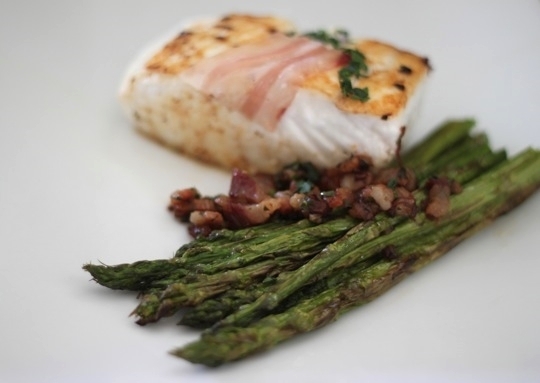 If something akin to “meat butter” sounds good to you, then head to your favorite local (or online) butcher shop and ask for pancetta, guanciale or lardo. All three are fatty cuts of pork – with an emphasis on fatty – that are dry cured with salt, herbs and spices.
If something akin to “meat butter” sounds good to you, then head to your favorite local (or online) butcher shop and ask for pancetta, guanciale or lardo. All three are fatty cuts of pork – with an emphasis on fatty – that are dry cured with salt, herbs and spices.
Guanciale comes from the jowl, lardo comes from the back and pancetta comes from the belly. The long curing time (usually a couple months or so) means these seriously tasty slabs of mostly fat marbled with a little meat can be eaten raw. This is usually done by draping very thin slices of pancetta, guanciale or lardo over cooked meat, fish or vegetables, so it melts like butter. Meaty, salty, extremely rich butter.
Especially if you plan to eat it raw, buy from butchers that sell high quality, humanely raised, pastured pork. Lardo, which is pure fat, is the most butter-like (and hardest to find in stores). Pancetta and guanciale have a little more texture and meaty flavor; kind of like bacon for really hardcore pork lovers. Pancetta is sold in slabs or rolls that are often sliced to order by the butcher and guanciale is sold in slabs that are often cut to order as well.
Both pancetta and guanciale can also be cut into cubes and fried up into crispy, fatty morsels, instead of eating it raw. This recipe is the best of both worlds: raw pancetta as a silky, porky topping for halibut and cooked pancetta mixed with sherry vinegar, shallot and parsley as a dressing for asparagus. The result is a meal worthy of a special occasion but easy enough to make any night of the week.
Servings: 2
Time in the Kitchen: 35 minutes
Ingredients:
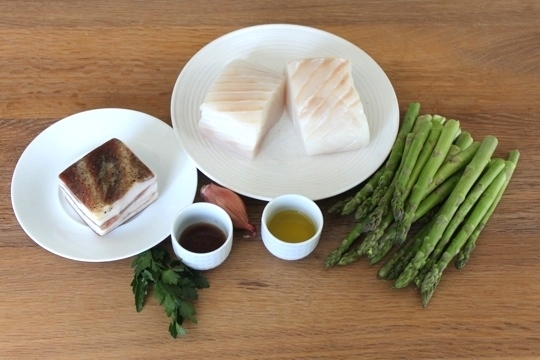
2 6-ounce (170 g) skinless halibut fillets
3 ounces of guanciale or pancetta (ideally cut from a slab, not a round) (85 g)
2 tablespoons finely chopped shallot (20 g)
1 tablespoon sherry vinegar (15 ml)
1 tablespoon finely chopped parsley (30 ml)
1 bunch of asparagus
2 tablespoons of olive oil (30 ml)
Instructions:
Slice 4 very thin slices off the piece of pancetta or guanciale and set aside. Cut the rest up into tiny cubes.
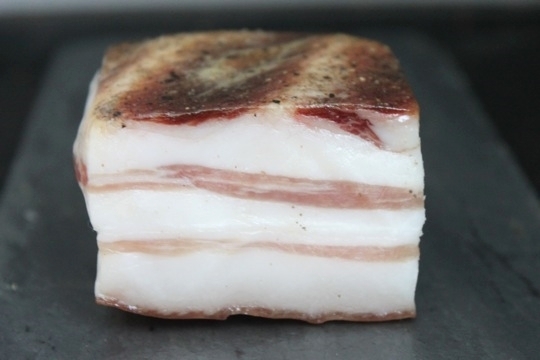
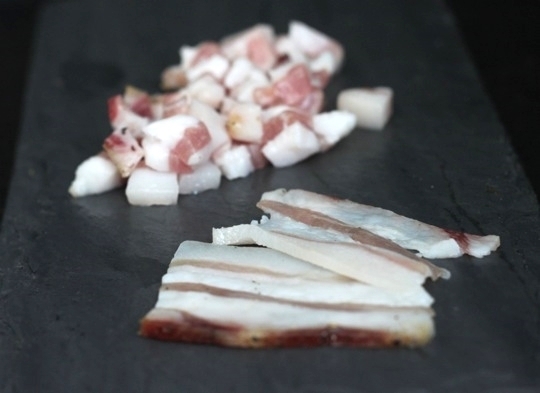
Heat a skillet over medium heat. Add the cubes of pancetta/guanciale and cook for 3 minutes then add the shallot. Continue to cook until the pancetta/guanciale is crispy. Pour off most of the fat (keeping the pancetta/guanciale and shallot in the skillet) and set aside.
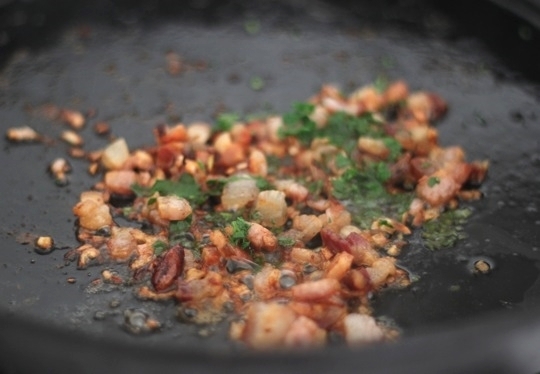
Add the vinegar and parsley to the skillet. Cook about 1 minute more, until most of vinegar evaporates, then spoon the mixture of pork, shallot and parsley into a bowl and set aside.
Pour the reserved bowl of grease back into the skillet. Turn the heat up to medium-high. Lightly salt the halibut and add it to the pan, cooking until browned on the bottom, about 5 minutes. If the pan starts smoking, turn the heat down to medium. Flip the fish and cook about 2 to 4 minutes longer, until opaque in the center.
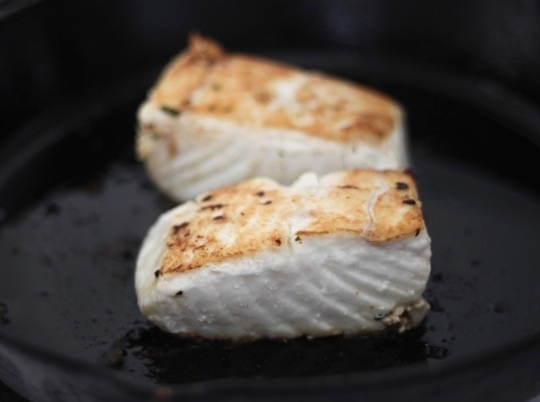
While the fish is cooking, coat the asparagus in olive oil. Lay out in a single layer in a rimmed baking pan. Sprinkle with salt and pepper. Broil under high heat, shaking the baking sheet occasionally, and cook until slightly shriveled and charred, 6 to 8 minutes.
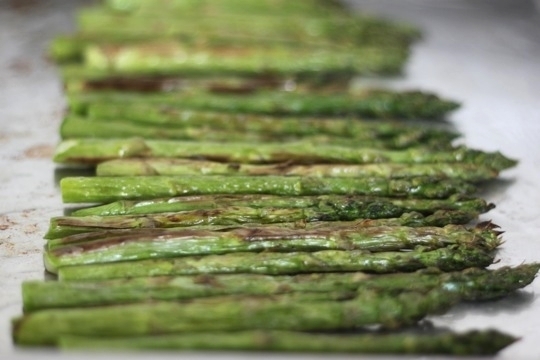
Plate each of the halibut fillets with two slices of raw pancetta/guanciale on top and asparagus on the side dressed with the pancetta/guanciale and parsley dressing.
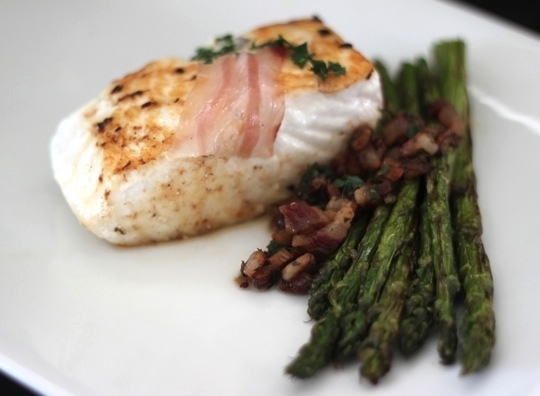
Not Sure What to Eat? Get the Primal Blueprint Meal Plan for Shopping Lists and Recipes Delivered Directly to Your Inbox Each Week




July 18, 2014
Long Distance Triathlete Finds Success with Primal
It’s Friday, everyone! And that means another Primal Blueprint Real Life Story from a Mark’s Daily Apple reader. If you have your own success story and would like to share it with me and the Mark’s Daily Apple community please contact me here. I’ll continue to publish these each Friday as long as they keep coming in. Thank you for reading!
 As a youngster growing up in Sydney, Australia, I had asthma that really limited what I could do. My mind wanted to do active sporty things, but physically I couldn’t follow through and as a result, was pretty unfit (and overweight).
As a youngster growing up in Sydney, Australia, I had asthma that really limited what I could do. My mind wanted to do active sporty things, but physically I couldn’t follow through and as a result, was pretty unfit (and overweight).
My mum was a good healthy cook and we spent lots of time outdoors, but I would sneak lollies, chocolate, and chips when I could. It wasn’t emotional eating – I just loved the flavours and textures. There was also peer pressure about buying “the cool food” (aka junk) for lunch at school and then University.
Flash forward a couple of decades and I was still overweight and on the roller-coaster ride of fad diets that I would follow for a while, then fail as they left me starving and weak. I wanted to lose weight and be healthy, but I didn’t want to suffer so much. To me, mental health is an important part of physical health, and starving myself on restrictive “diets” left me mentally unhealthy. I found this unsustainable.
So what did I do? I exercised more (it helped that I found an asthma medication that worked). I was living in California now and really got into long distance cycling – which was great for being able to eat more. But again, this was unsustainable as work and other hobbies were bound to cut short my cycling hours! When I moved back home to Australia, the small town I moved to didn’t have much in the way of bike routes (or hills!) but they did have a triathlon club. So that’s what I took up next! Problem was, on a bike your weight is more forgiving than running. So I suffered. I was injured, I was tired, and I was slow.
I followed the conventional wisdom of high carb, low fat. I was still injured, tired, and slow. And it never seemed to get any easier, no matter how much I tried or trained. But I was also stubborn, so I kept going as I did actually enjoy the challenge. I followed the conventional wisdom of carb loading before a race and getting energy gels and sports drinks during. And I still suffered. I always had a stomach upset of some sort that began on the bike and manifested as multiple toilet stops on the run. After four half Ironman and four full Ironman triathlons, I finally started to ask some QUESTIONS rather than what I had been doing all these years – telling myself it was ME that had failed in some way. For so long I had followed CW around a “healthy diet” and what I needed to eat to do sports. And they weren’t working for me!!
My first port of call was a triathlon Internet community, where someone mentioned fructose intolerance. Being the scientist I am, I set up an n=1 study of different sugar solutions and tested myself. Lo and behold, fructose sent me to the bathroom. But I wasn’t done. I kept exploring the Internet around fructose, food issues, and exercise, and stumbled across Mark’s Daily Apple. THAT’S WHEN EVERYTHING CHANGED.
I read and read and read everything I could on the website that day (at work). And I started. Then and there. From the very next meal. I was so convinced that this had validity that I knew I needed to act straight away. I didn’t want to end up in that corner of “paralysis by analysis” or needing to know EVERYthing before I did ANYthing. I bought The Primal Blueprint book and read it cover to cover. Twice. I tweaked what I had been doing since that first day. I read more, and I tweaked more. I then started challenging my own long held beliefs (brainwashing) around the conventional wisdom of carbs for life and for sports.
I read some more and came across the concept of low carb/ketogenic diets for sports. The ketogenic concept seemed more suited to long endurance type efforts, which was perfect for me. The shortest race I do is six and a half hours, so I was hooked. I believed all my problems with race-day stomach issues were to be blamed on carbs – so if I could burn fat (and I had plenty to spare!) for fuel and avoid ingesting carbs, I could feel awesome! Talk about being excited!
So I followed a very low carb version of the PB, including copious amounts of dairy. I spoke to a sports nutritionist who has done work around fat adaptation in cyclists and he was on board. In fact, he thought I could do my next triathlon (a six hour event) totally carb-free if I was well enough adapted. I had three months to become keto-adapted before the race – and I was going to need those three months for some pretty decent training too. When I started, I was a bit skeptical and always carried carb gels on my training rides and runs. But the amazing thing was I could now head out for a four-hour ride or a three-hour run and not need any calories. I was AMAZED!! My training was going better than ever and I was recovering from my long workouts better. I wasn’t sore for days after a run, so I could back up sooner with another quality workout.
However, I remained skeptical that I could complete a six and a half hour race without ingesting calories, so I raced carrying a flask of “back-up” carbs for when I hit the wall. But I never did. I had steady energy and mental clarity through the whole event – something I have never experienced before. And, all this was on electrolytes and water for six and a half hours of effort.
This event really cemented in my mind that I was almost in a place where I had found an eating style that works for MY body. I explored more experts online, including listening to podcasts from Ben Greenfield, Abel James, Jonathon Bailor, Stephen Phinney, and Jeff Volek. I also found an awesome book by Dean Dwyer called Make Shi(f)t Happen. These sorts of folks really helped me explore ways to tweak MY lifestyle in conjunction with all the great info and MDA.
One of the things I did read on a bunch of websites were all the folks who said the weight literally fell off them when they started eating this way. I haven’t had those spectacular results. But I am slowly and steadily losing fat and getting stronger. So even though the weight isn’t falling off me, I’m getting better every day.
After Christmas I noticed I seemed to have stalled in any weight loss. So I began tweaking some more and using the PB as just that – a blueprint that could be moulded to suit my individual body. I made the decision to cut out dairy. It was a biggie for me, as I had come to rely on cheese and cream as a source of fat. I started to again lose small amounts of weight each week. My skin improved, as did my allergies and nose stuffiness. Coconut cream became my “go to” for creaminess, as well as cooking in coconut oil or duck fat.
My last tweak (care of MDA) was a version of Bulletproof coffee. The ingredients in this are a particular type of coffee, with butter and MCT oil. Well, I started just by blending some MCT oil in my regular coffee in the mornings. UNBELIEVABLE. I have really noticed more clarity and sharpness in my mind during the day and don’t crave carby things or rely on caffeine to get me though the workday.
I’m still not going to be winning any races. Frankly, I’m not much faster than I was. But my lack of speed really comes down to the amount of training I can do within all the other parts of my life. So what are the benefits then? I FEEL AWESOME!! My health has improved. I ENJOY my training and events more. I DON’T SUFFER from stomach problems or energy ups and downs during these events or in everyday life. I don’t suffer muscle soreness for days after a strenuous workout. I appreciate more the fitness and health that has come from my eating shift. And I’M NOT CONSTANTLY HUNGRY!!
So what’s a typical day for me? (While training 9-13 hours a week and an 8-5 job):
Coffee with unsweetened almond milk
45–60min workout
7:30am Breakfast – Bacon & egg yolks cooked in coconut oil
10:30 – Decaf coffee with MCT oil
2pm Lunch – Leafy greens with 125g meat/fish, avocado, olive oil
4:30 – Walnut/macadamia mix
5:30 – Afternoon workout – 60min
7:30 Dinner – 125g meat, ½ cup low carb veg, cooked in duck fat
I also make myself some treats on long training weekends that consist of coconut oil, almond butter, cocoa, and desiccated coconut, frozen in ice cube trays. Talk about YUM!
I bought myself a blood ketone meter and have done a lot of measurements to see how different foods/volumes affect my ketosis. More than around 200g protein or two alcoholic drinks sets me down to around 0.5mmol. I normally sit around 1.5-2 mmol since giving up the dairy. That’s probably the only reason I monitor how much meat I consume. I do try and keep my carbs down below 40g/day, but I don’t measure – just eat small amounts and don’t go silly on the nuts! No starchy vegetables and absolutely no grains, sugars, or legumes.
So round two of ketogenic racing was another long triathlon – this time there were going to be some serious hills in the bike part. Since exploring MCT oil as a supplement on a normal day and listening to folks like Ben Greenfield (an ironman triathlete), I started blending some MCT oil into some amino acids and electrolytes for my planned race nutrition. My training and recovery improved EVEN MORE. My mood and mental clarity improved EVEN MORE. So I went into this race with this plan:
Pre race brekky – Bacon, egg yolks, coffee with MCT oil
Immediately pre-start – ¾ tbsp MCT oil, 5 g BCAA’s
During the bike and run – ¾ tbsp MCT oil and 5g BCAA’s per hour
Not your typical carb loading and carb fest that is usually long distance triathlon!
So how did I go?
I had some serious mechanical problems towards the end of the bike leg, and ended up being out there for around 40min longer than I planned. I only consumed less than half of the MCT oil/aminos that I had packed. BUT IT WAS AWESOME!! I felt great though the swim, strong and consistent through the bike (serious hills and long flats), and set a personal best (PB) for the run leg. Even though I had problems on the bike, my mental state was so much clearer and positive than any race I had previously done. Seven hours and 40 minutes on essentially just a few electrolytes.
And here’s the kicker: all those foods I thought I craved over the last few months? I let myself have them over the following couple of days – bread, milk, butter, cake, and chocolate. And guess what happened? I felt like crap. My skin and eyes were itchy, my face broke out in zits, my stomach was upset, I was bloated, had a headache, and puffed up 4kg in 3 days! And the best part? Nothing tasted good or gave me any satisfaction to eat. I won’t be doing that again!
So what are the biggest lessons I learned?
1. PB = Primal Blueprint. AND PB = Personal Best. BE YOURS!!
2. There is no one answer. Read, re-read, and experiment on yourself. Constantly tweak what you do. Dean Dwyer (in Make Shi(f)t Happen) talks about thinking in Beta (i.e., constantly tweaking yourself like multiple releases of a computer program) and not following prescriptions. Too many “solutions” out there just tell you what to do. Places like Mark’s Daily Apple and PB encourage exploration as to WHY you might want to try things and how to uncover what will work best for you. And that really sets them aside from all the CW out there.
And that’s my story. Thanks for reading, and all the best!
Cath
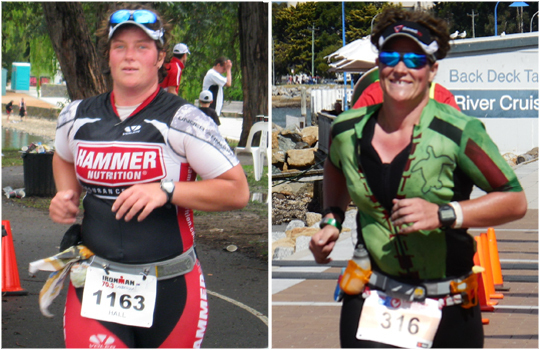
Before, Left. After, Right – A bit lighter, but a LOT healthier and happier
Join Mark Sisson and Friends in Sunny Southern California this Sept. 25-28! Get Your Tickets for PrimalCon Oxnard 2014 Today and Finally Meet Your Tribe!




July 17, 2014
9 Signs You Need to Eat More Fat
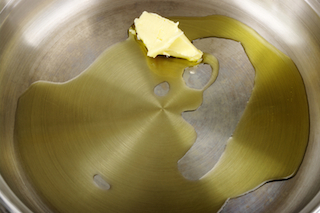 By now, we all basically agree that fat is an essential nutrient. Certain fats, like linoleic acid and alpha linolenic acid, are physiologically essential because our bodies cannot produce them. Other fats, like those found in extra virgin olive oil and grass-fed butter, are culinarily essential because they make food taste really good (they’re not so bad in the nutrition department, either). And others are conditionally essential, meaning they become extremely helpful and even critical in certain situations. But how much is enough? How do we know when to increase our intake of specific fats?
By now, we all basically agree that fat is an essential nutrient. Certain fats, like linoleic acid and alpha linolenic acid, are physiologically essential because our bodies cannot produce them. Other fats, like those found in extra virgin olive oil and grass-fed butter, are culinarily essential because they make food taste really good (they’re not so bad in the nutrition department, either). And others are conditionally essential, meaning they become extremely helpful and even critical in certain situations. But how much is enough? How do we know when to increase our intake of specific fats?
There are a few indicators that you might need more fat. If any of the following issues are giving you trouble or sound familiar, consider increasing your intake of fat. It may very well help solve your problem.
You have dry skin.
Dry skin can mean a lot of things – allergic reactions, imbalanced gut microbiota, topical exposure to abrasive chemicals - but it often means that you simply need more fat in your diet. How so? Sebum is the body’s natural moisturizer, and we produce it in-house using the fatty acids that are available. Some of the fats come from our own body stores, of course, while others have to come from the diet, especially if we’re not actively losing body fat or we don’t have much to spare. Increasing fat intake, then, is a painless, simple way to potentially improve your skin’s moisture levels.
You’re low-carb and feeling “off.”
Fat is still a bad word in many circles. How many people have seen this happen? A person reduces carb intake to lose weight without realizing that they need to increase their consumption of fat to make up for some of the missing energy. They begin losing weight, but the exhaustion, lack of energy, malaise, and headaches make it hard to stick to the plan. Since fat is still a bad word in most circles (though that’s changing), what happens all too often is a person will reduce carbs and keep their fat intake way too low. If they’re burning lots of body fat in the process, that can certainly help with energy needs, but most people will also need to increase the fat they eat.
Your physical performance is lagging.
People are quick to suggest upping carb intake when physical performance suffers. Depending on the nature of the performance, that may help in certain cases. But another macronutrient also plays a big role in physical performance: fat, specifically saturated fat. We use saturated fat (and the cholesterol that often comes packaged with the fat) as precursors to steroid hormones like testosterone. Without enough saturated fat in the diet, we can’t make enough testosterone. Without enough testosterone, we can’t build muscle, recover from our workouts, or enjoy a healthy libido.
Your joints ache.
Achy joints can mean a lot of things. You could have poor mobility, improper movement mechanics, and tight surrounding musculature and fascia. You could have arthritis. You could have suffered an acute injury that’s just now manifesting. Whatever the cause, reducing inflammation through dietary means can really help dull the pain and even improve the underlying issue. Whenever I have a sore knee or a creaky hip, I eat more fatty fish or increase my fish oil intake for a few days. The omega-3s are anti-inflammatory and have even been shown to improve symptoms in patients with rheumatoid arthritis. If animal models of osteoarthritis hold true for humans, omega-3 intake can even enhance wound and joint repair following joint injury.
You have low HDL.
Getting regular exercise, moderate alcohol consumption, and weight loss all increase HDL – and health professionals are quick to mention those as viable options. But eating more fat, particularly saturated and monounsaturated fats, can also increase your HDL. This isn’t very surprising, actually, as both exercise and weight loss involve the oxidation of stored body fat, which is similar to eating a bunch of (human) animal fat. Maybe that’s one reason why losing body fat is so good for us and results in so many improvements to health markers – it inadvertently places us on a high-animal fat diet (regardless of the diet used to achieve the fat loss). Some fats are better than others at increasing HDL. Saturated fats like the ones in coconut oil increase HDL, while the PUFAs found in soybean oil tend to lower it.
You’re never satisfied after meals.
Low-fat diets are notorious for making their adherents ravenous, whereas low-carb, high-fat diets are well known for curbing out-of-control appetites. Most people attribute that to the higher protein content of low-carb diets. I’m not so sure that’s the whole story. In my experience, loading up on protein alone makes me sick of eating and slightly repulsed by food, whereas eating fatty meats satisfies me. Both reduce appetite, to be sure, but I prefer to be sated rather than repulsed. Plus, fatty cuts of meat, not just the lean stuff, provides saturated and monounsaturated fats (along with protein). Saturated fats appear to confer the most satiety via the satiety hormone PPY, whereas monounsaturated fats from olive oil have favorable effects on another satiety hormone, GLP-1.
You’re trying to love vegetables.
Edible vegetation is essential for optimal health. Maybe not ten cups a day of leafy greens or anything, but some really does help round out the diet and provide vital nutrients that are otherwise tough to get elsewhere. The problem for many people is the “edible” part of that equation. Plain vegetables simply don’t taste very good – at least until you develop a palate that can appreciate them. Here’s where fat comes in. Fat transforms vegetables into delicious meal accompaniments. Steamed broccoli is tolerable plain. Toss it with some grass-fed butter, salt, and black pepper and it becomes irresistible. Toddlers, with their instinctual distrust of vegetation, develop a taste for even the dreaded Brussels sprout more quickly when paired with fat. Vegetable are loaded with vitamins and minerals and antioxidants and fermentable fiber. They’re some of the healthiest things a person can consume, but you do have to actually eat them.
Your mental edge seems dulled.
Part of the transition into lower-carb eating involves a period of mental dullness for many people. You’re eating fewer carbs, which means less glucose is available for your brain, and your metabolic machinery hasn’t quite caught up to begin burning fat and ketones efficiently for energy. But what if this persists? A number of studies show that eating specific fatty acids – medium chain triglycerides, whether found in refined MCT oil or in coconut oil – can improve cognitive function by increasing ketone availability. Interestingly, access to ketones (whether through ketosis or medium chain triglycerides) doesn’t impair the brain’s ability to utilize glucose. When the brain’s access to ketones increases, so does its uptake of glucose. Oh, and krill oil, which contains omega-3 fats in phospholipid form, may also improve cognitive function.
You’re going out drinking.
If you plan on drinking more than a serving or two of alcohol, increasing your intake of certain fatty acids and decreasing your intake of others before can protect your liver from injury, reduce the toxicity, and diminish the resulting hangover. Saturated fats appear the most hepatoprotective, with the fats in dark chocolate and coconut/MCT oil being especially helpful; linoleic acid/omega-6 is the most dangerous when drinking alcohol. You’ll get the best results by eating more SFA and less linoleic acid several days (or weeks, months, or years) prior and up to imbibing, since it takes a few days to shift the composition of your liver fat.
That’s it for today, folks. Hopefully you find these tips useful, whether for your own burgeoning high-fat diet or someone else’s.
Thanks for reading.
Get the 7-Day Course on the Primal Blueprint Fundamentals for Lifelong Health Delivered to Your Inbox for FREE




Mark Sisson's Blog
- Mark Sisson's profile
- 199 followers




